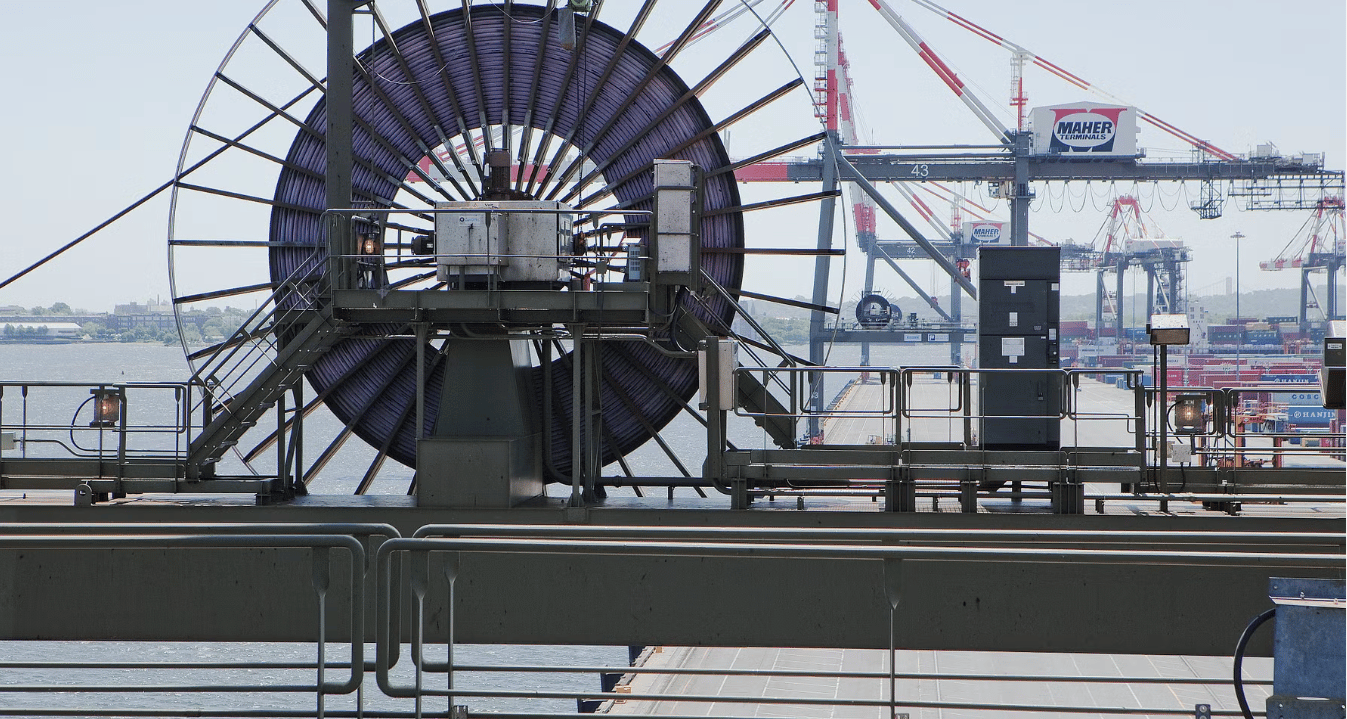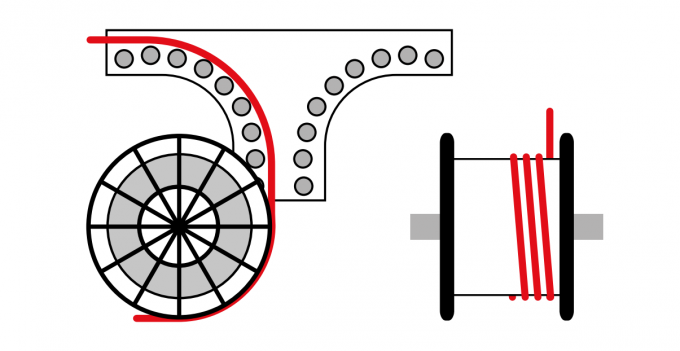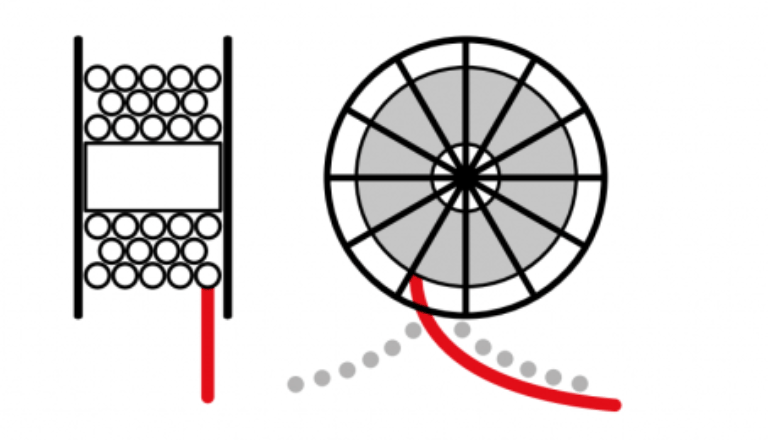📞+86 153 7530 2641 📧 hongjing.Wang@feichuncables.com
Engineering Principles of Cable Winding Reels: Types, Calculations & Material Selection Guide
Explore the engineering principles behind cable winding reels, including monospiral, level, and random types. Learn how material choice, stress analysis, and winding methods impact durability and performance in industrial systems.
hongjing.Wang@Feichun
7/11/20258 min read


Introduction: The Critical Role of Cable Winding Reels
Cable winding reels serve as the backbone of countless industrial operations, from towering port cranes that orchestrate global commerce to offshore platforms battling harsh marine environments. These sophisticated mechanical systems represent far more than simple cable storage solutions—they are precisely engineered components that directly impact operational efficiency, safety, and equipment longevity.
In port environments, cable winding reels manage the electrical and control systems that power massive container handling equipment. These systems must withstand constant motion, extreme weather conditions, and the demanding duty cycles of 24/7 operations. Similarly, offshore installations rely on cable winding reels to maintain critical power and communication links while enduring salt spray, temperature fluctuations, and mechanical stress that would quickly destroy improperly designed systems.
The engineering principles of cable winding reels extend beyond basic mechanical function to encompass sophisticated calculations for stress distribution, material selection optimized for specific environments, and innovative designs that maximize cable protection while minimizing maintenance requirements. Understanding these principles is essential for engineers, maintenance professionals, and operators who depend on reliable cable management systems.
Overview of Engineering Principles Behind Cable Reels
A reliable reel system distinguishes itself through several fundamental engineering characteristics that work in harmony to ensure optimal performance. The primary engineering principle centers on controlled tension management—the ability to maintain consistent cable tension throughout the winding and unwinding process while preventing excessive stress that could compromise cable integrity.
The key functions that define superior reel design include precise tension control mechanisms that automatically adjust to varying load conditions, minimized wear characteristics achieved through careful material selection and surface treatments, and guided retraction systems that ensure proper cable positioning throughout the operational cycle. These functions require sophisticated engineering calculations and mechanical compatibility assessments that account for the dynamic forces present in industrial environments.
Engineering calculations form the foundation of reliable reel systems, encompassing stress analysis to determine load-bearing capacity, fatigue analysis to predict service life under cyclic loading conditions, and thermal analysis to ensure performance across temperature ranges. Mechanical compatibility extends beyond simple dimensional matching to include considerations of rotational inertia, acceleration profiles, and the complex interactions between electrical and mechanical systems.
The importance of these calculations becomes apparent when considering the consequences of failure in critical applications. A cable reel failure in a port crane can halt operations affecting thousands of containers, while offshore platform failures can compromise safety systems protecting personnel and environmental resources.
Reel Types Explained: Applications, Advantages & Drawbacks
Monospiral Winding Reels
Monospiral winding reels represent the premium solution for applications requiring high tension capacity and precise cable organization. These systems wind cable in a single-layer spiral pattern, creating a neat, organized arrangement that maximizes the effective use of drum space while maintaining excellent cable protection characteristics.
The advantages of monospiral systems make them ideal for heavy-duty applications where reliability cannot be compromised. Their ability to withstand high tensile loads stems from the even distribution of forces across the drum surface, while the organized winding pattern ensures consistent cable direction and prevents the tangling or overlapping that can cause premature failure. The controlled cable direction during winding operations provides operators with predictable behavior, essential for precise positioning applications.
However, monospiral vs level winding reels for heavy-duty use comparisons reveal specific limitations. Direction changes at high speeds can be challenging due to the mechanical complexity required to maintain the spiral pattern. Internal metal components may cause abrasion in certain cable types, and the cable may experience stiffening in cold temperatures that affects winding characteristics.
Spreader Reels
Spreader winding reels excel in applications where vertical pulling forces dominate the loading conditions. These systems distribute cable load across a metal drum using specialized spreading mechanisms that accommodate the unique stress patterns of vertical cable runs.
The primary advantage lies in their exceptional ability to withstand high tensile forces while preventing cable damage to the drum structure. This makes them particularly suitable for applications such as crane hoisting systems where vertical loads predominate.
The disadvantages include potential slippage during winding operations and an elevated risk of abrasion due to the spreading mechanism's contact with the cable. These limitations require careful consideration during system selection and may necessitate additional protective measures.
Random Winding Reels
Random winding reels offer a cost-effective solution for applications involving flexible, lightweight cables where precise organization is less critical than economic considerations. These systems allow cable to wind naturally onto the drum without mechanical guidance, reducing complexity and initial cost.
The cost-effectiveness and suitability for short-term use make random winding systems attractive for temporary installations or applications with limited budget constraints. However, the cable may experience bending and deformation that can compromise long-term performance, and electrical conductivity may be affected by the uncontrolled cable positioning.
Level Winding Reels
Level winding reels represent the most sophisticated approach to cable management, utilizing specialized guiding mechanisms to ensure even cable distribution across the drum surface. These systems incorporate precision mechanical components that automatically traverse the cable across the drum width, creating uniform layers that maximize cable life and system reliability.
The advantages include enhanced cable longevity through controlled bending radii and uniform stress distribution, plus greater resistance to environmental factors due to the protected cable arrangement. However, the complexity results in higher initial costs and more sophisticated mechanical structures that require skilled maintenance personnel.
Engineering Calculations for Cable Winding Systems
Stress analysis in cable reel design begins with the fundamental relationship between applied force and material cross-sectional area. The stress analysis formula σ = F/A provides the foundation for determining safe operating loads and selecting appropriate materials. In practical applications, this calculation must account for dynamic loading conditions, safety factors, and the complex stress distributions that occur in curved cable paths.
The minimum bending radius for flexible cable winding requires careful consideration of material properties and allowable stress levels. The minimum bending radius formula R_min = E/(2·τ) establishes the relationship between elastic modulus (E) and shear stress (τ) to determine the smallest allowable bend radius without causing permanent cable damage.
In port machinery installations, these formulas find practical application in determining drum diameters, calculating required motor torques, and establishing safe operating speeds. For example, a typical container crane application might require stress analysis to ensure cable systems can handle the combined loads of container weight, wind forces, and dynamic acceleration without exceeding material limits.
Real-world applications also require consideration of cyclic loading effects, where cables experience repeated bending and straightening cycles. Fatigue analysis becomes crucial in determining service life and maintenance intervals, particularly in high-duty-cycle applications where millions of operations occur annually.




Material Selection for Reels: Strength vs Environment
Material selection for industrial cable reels requires balancing strength requirements against environmental conditions, cost considerations, and maintenance requirements. Steel remains the traditional choice for heavy-duty applications, offering exceptional strength characteristics and proven reliability in demanding environments. However, steel's weight penalty and corrosion susceptibility in marine environments require careful consideration.
Aluminum provides an attractive alternative where weight reduction is prioritized, offering significant advantages in mobile applications and situations where structural loads must be minimized. The lower strength characteristics of aluminum require careful engineering to ensure adequate safety margins, but the corrosion resistance and thermal properties often justify the additional design complexity.
Composite materials represent the cutting edge of reel construction, offering exceptional corrosion resistance and tailored mechanical properties. The ability to engineer composite materials for specific applications enables optimization of strength-to-weight ratios and environmental resistance characteristics. However, the higher cost and specialized manufacturing requirements limit their application to premium systems where performance justifies the investment.
Corrosion resistance in marine and offshore use becomes a critical selection criterion, as salt spray and humidity can rapidly degrade inappropriate materials. Protective coatings, galvanization, and material selection must work together to ensure long-term reliability in these challenging environments.
Environmental Factors and Their Engineering Impact
Environmental conditions significantly influence reel design requirements and material selection decisions. Saltwater environments present unique challenges through accelerated corrosion, salt crystal formation, and the conductive properties of salt deposits that can affect electrical systems. UV exposure degrades many materials over time, requiring careful selection of protective coatings and UV-resistant materials.
Temperature extremes create thermal stress conditions that affect material properties and dimensional stability. Expansion and contraction cycles can cause mechanical stress in cable systems, while extreme temperatures may affect cable flexibility and electrical properties. Design adaptations for ports and mobile cranes must account for these environmental factors through appropriate material selection, protective systems, and operational procedures.
Cable winding reel types for harsh environments require specialized design features such as sealed bearing systems, corrosion-resistant coatings, and drainage systems to prevent water accumulation. Environmental sealing becomes critical in preventing contamination of mechanical components while maintaining accessibility for maintenance operations.
Future Trends: Automation and Smart Cable Reel Systems
Automatic cable winding systems for cranes and ports represent the next evolution in reel technology, incorporating sophisticated control systems that optimize cable handling while reducing operator workload. These systems utilize sensors, feedback controls, and automated positioning to maintain optimal cable tension and winding patterns throughout the operational cycle.
Predictive maintenance capabilities enabled by sensors and IoT technologies promise to revolutionize reel system reliability. Real-time monitoring of tension, temperature, vibration, and other parameters enables early detection of potential problems before they result in system failures. Data analytics can identify patterns that indicate wearing components or degrading performance, allowing maintenance to be scheduled optimally.
Sustainability considerations are driving innovation in material sourcing and life-cycle design approaches. Manufacturers are exploring recycled materials, renewable energy sources for manufacturing processes, and design strategies that facilitate component reuse and recycling at end of service life.
Smart cable reel systems integrate with broader industrial automation systems, providing operational data that enables optimization of entire facilities. The ability to coordinate cable reel operations with crane scheduling, maintenance planning, and energy management systems creates opportunities for significant efficiency improvements.
Conclusion: Matching Reel Design with Real-World Applications
The engineering principles underlying cable winding reels demonstrate the sophisticated analysis required to create reliable, efficient systems for demanding industrial applications. From the fundamental stress calculations that ensure safe operation to the complex material selection decisions that determine long-term reliability, every aspect of reel design must be carefully considered and optimized for specific applications.
The importance of proper engineering cannot be overstated when considering the long-term cable reliability and operational efficiency that depend on these systems. A well-engineered reel system not only protects valuable cable assets but also ensures consistent performance that enables productive operations and minimizes costly downtime.
Choosing the right reel type requires careful analysis of operational requirements, environmental conditions, and performance expectations. Engineers must consider factors such as load capacity, duty cycle, environmental exposure, and maintenance requirements to select the optimal combination of reel type, materials, and features. Operational data and established standards provide the foundation for these decisions, ensuring that selected systems meet both immediate needs and long-term reliability requirements.
The future of cable winding reel technology lies in the integration of advanced materials, smart control systems, and predictive maintenance capabilities that will further enhance reliability while reducing operational costs. As industrial operations become increasingly automated and data-driven, cable reel systems will continue to evolve to meet these changing demands while maintaining the fundamental engineering principles that ensure safe, reliable operation.
Frequently Asked Questions
Q: What factors should be considered when selecting between monospiral and level winding reels for heavy-duty applications?
A: The choice depends on several key factors: load capacity requirements, precision needs, environmental conditions, and maintenance capabilities. Monospiral reels excel in high-tension applications with straightforward winding patterns, while level winding reels provide superior cable protection and longevity in complex duty cycles. Consider the specific tension requirements, available maintenance expertise, and long-term operational costs when making this decision.
Q: How do environmental conditions affect material selection for cable reels in marine applications?
A: Marine environments require materials that resist salt corrosion, UV degradation, and thermal cycling. Stainless steel, aluminum with protective coatings, or advanced composites are preferred over standard steel. The design must also incorporate drainage systems, sealed bearings, and corrosion-resistant fasteners to ensure long-term reliability in saltwater environments.
Q: What are the critical engineering calculations needed for cable reel design?
A: Essential calculations include stress analysis using σ = F/A to determine safe operating loads, minimum bending radius calculations using R_min = E/(2·τ) to prevent cable damage, fatigue analysis for cyclic loading conditions, and thermal analysis for temperature-related effects. These calculations must account for dynamic loading, safety factors, and environmental conditions specific to the application.
Q: How do automatic cable winding systems improve operational efficiency?
A: Automatic systems provide consistent tension control, reduce operator workload, minimize cable wear through precise positioning, and enable predictive maintenance through integrated sensors. These systems can optimize winding patterns, prevent cable damage from improper handling, and integrate with broader facility automation systems for enhanced operational coordination.
How to Reach Us
Get in Touch
SiteMap
Product Catalogue
Reeling Cable
Festoon Cable
Shore Power Cable




Scan to add us on WeChat
